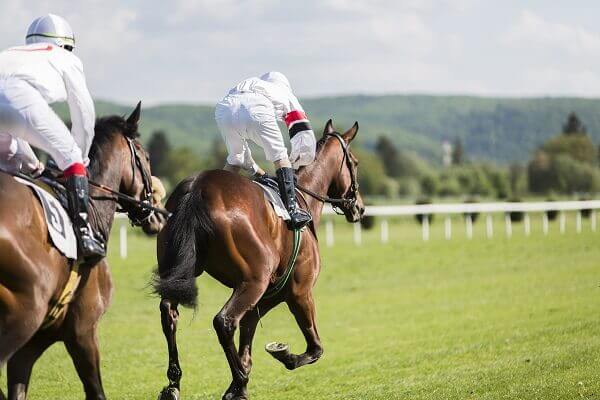Last Updated:
Are you ready to find out some of the most useful horse racing betting tips, which include reading markets, race aspects to look for, main events and their elements, and major horse racing terms?
If your answer is yes, we’re here to show you the tips and tricks for one of the oldest sports, which people used to bet on even in ancient times. Have a scroll or two and see what this world brings.
Types of Horse Racing Bets
One of the first betting aspects horse racing fans should get familiar with are markets. Of course, every platform, which has a diverse horse racing betting section featuring countless markets. But here are some of the main ones which can come in handy for you to start with.
Win
The “win” bet is standard and straightforward. It refers to picking only one horse that you think will win the race. You’ll have only one selection on your slip.
Show
The show is also a very simple betting market. This is because it requires you to pick a horse that will end up in the 1st, 2nd, or 3rd spot. If your horse finishes in one of these positions, your bet will win.
Place
Keeping with single bets, there’s a “place” market that you can use to predict if a horse will finish in the first two, first three, or first four positions in a race. The number of positions depends on the number of horses in a race.
Exacta
Exacta is the actual combination of the win and place bets. In other words, you estimate which horse will win and which one will take the second spot, i.e., the first two finishers in the race.
Trifecta
Another level of predicting the exact order in which horses will finish the race is related to the Trifecta market. It’s all about predicting which horses will end up in the first three positions, but also the exact order in which they will do this.
Superfecta
The most advanced level of estimating horse positions in exact order goes to the Superfecta market. This bet implies that you try to successfully pick horses that will finish the race in the first four spots, in the exact order.
Daily Double
If there are two consecutive races on one specific race track, you can place a Daily Double bet. This kind of bet stands for predicting the winner of two races in a row. You need to place a bet before any of the races start, and your bet will be a win only if both selections are correct.
Pick 3 (or Pick 4, Pick 5, Pick 6)
Pick 3, 4, 5, or 6 markets represent the advanced Daily Double market. More specifically, you need to predict the winner of three, four, five, or six consecutive races.

All these bets are important to understand because they stand for the horse race betting basics. Once you get to know them well, you can place standard bets, as well as make enough room for more advanced horse racing predictions.
Different Types Of Horse Racing Bonuses
Achieving fluency in the language of horse racing is essential for betting success, but it can be a challenging journey. Below, you’ll discover an explanation of horse racing bet varieties, providing you with the knowledge needed to begin betting on horse racing confidently and effortlessly. Also, make sure to be aware that when placing bets on horse races, many bookmakers offer great promotions, such as bonus bets or enhanced odds.
Betting bonuses and promotions in horse racing can take numerous forms:
- Deposit match bonuses: New customers receive horse racing bonuses based on the size of their initial deposit. For instance, a customer depositing $100 with a 100% match bonus would receive an additional $100 in cash or site credit.
- First bet reimbursements: Certain horse racing betting platforms extend an offer to new users, allowing them to place their first bet with a refund guarantee. For instance, an online racebook might refund new customers if their first win, place, or show bet results in a loss.
- Cashback and betting rebates: Popular among bettors, cashback rebates at horse racing betting sites offer ongoing rewards for loyal users and issue rebates on all wagers, regardless of the outcome.
- Close call reimbursements and betting insurance: Close call refunds are common horse betting promotions. For example, a racebook might promise to refund all WIN bets placed on horses finishing second or third in select races.
- Complimentary past performances: Many racebooks provide free past performances as a bonus by reimbursing users who purchase a past performance and place a bet on that race.
- Bonus deposits: Promotions offering bonus deposits waive the customary fees charged by most horse racing betting platforms when users load their accounts via credit card, debit card, or PayPal.
What You Need to Know Before Betting on Horses?
No beginner should jump straight into horse racing betting without checking some horse racing strategies beforehand. That being said, we introduce you to doing research on various aspects of horse racing, which is important for safe betting and can also influence your success rate. In fact, we recommend considering multiple factors in order to make unified and informed decisions, as shown below.
Horse Form
Selecting the best horses to bet on first requires you to check their form. Moreover, you can read the results from the most recent races a horse was part of.
Additionally, the consistency horses have over time is also something to look into. Finally, you may get information about a race track and see how a certain horse usually performs in similar conditions.
Jockey Statistics
The second key element besides a horse includes jockeys and their stats. Firstly, you can take a look at some numbers and see a jockey’s winning percentage.
Also, you may consider a jockey’s performance on a particular track (if they are used to it, how many times have they raced there before, etc). In addition to statistics, the relationship a jockey has with a horse and a trainer is also very important.
Trainer Record
Adding the trainer element to horses and jockeys is also something you may want to do. More so, you can get information about a trainer’s overall success rate.
If you want to be more specific, you can have a look at the trainer’s record with particular horses or races. And so knowing about the current stable, which horses are there, and their recent form can be helpful, too.
Track Conditions
Every open event is under the influence of weather and other conditions. Even before that, learning about the type of a track, i.e., its surface, is crucial. A track can either be turf, dirt, or synthetic.
Each horse has its preferred tracks, depending on the speed, stretch, or so. Let’s not forget about weather conditions. Some horses perform better than others in humid conditions, and rarely does any horse enjoy the heat.
Class Level
The higher the class, the more demanding it is for horses to compete, and vice versa. However, not every horse is in shape for the strongest competition. That’s why it’s advisable to compare classes and horses.
The more detailed outlook on this would be to track horses’ progress when they move from one class to the next. All this results in the general class performance, which we, in our horse betting guide, do not mention lightly.
Distance Suitability
Finally, not every track has the same distance. It goes without saying that different horses perform differently based on the length of the race. The easy way to check this is by putting tracks of various lengths and horses that performed there side to side.
Furthermore, the major indicator of horses’ potential performance at certain lengths is their pedigree. Some horses are typically bred for longer or shorter distances.
If you are a fan of horse racing, the thrill of competition and the strategic element of betting will likely resonate with the excitement of MotoGP. Both sports demand a deep understanding of the athletes, conditions, and a touch of luck.
Beginner’s Tip
Every newcomer to the world of horse racing betting should know how to stay on the safe side of betting. So, our best horse racing advice is to start off slow. More precisely, you need to get informed about how to sign up on a brand’s site and how betting works in general.
Afterward, you should get an insight into the events you wish to bet on (tracks, horses, past results, forms, etc.). Going back to the safe side of betting, we recommend placing bets with small sums of funds at first. Plus, we advise you to keep track of your bankroll and know when to stop and not to chase any potential losses.
What Are the Biggest Racing Events in the USA?
The popularity of events varies from one race to another, but the most famous ones always bring much attention. Not only that, but well-known and well-liked horse racing events are a great opportunity for users to place bets.
The reason for this is that big sponsorship and prizes are involved, with sportsbooks allowing you to be part of big potential-prize promotions, as well.

Kentucky Derby
The Kentucky Derby is the first event to be part of the Triple Crown. The Triple Crown races have a long and special tradition and are very popular among horse racing fans.
As for the dates, the Kentucky Derby is held every year on the first Saturday in May. The exact location of the event is Churchill Downs, Louisville, Kentucky. Before the event itself, there’s a Kentucky Derby Festival. The first race was run in 1875.
This race is 1 1⁄4 miles long, with three-year-old Thoroughbreds competing in it. The typical purse size of this event is around $5 million. This amount is distributed among the winners.
You may bump into plenty of online sites where you can bet on this racing event. Most of them feature all the most famous betting markets, with some competitive odds. The minimum stake amount is usually also flexible.
Preakness Stakes
The second big event which is also part of the Triple Crown, Preakness Stakes, takes place two weeks after the Kentucky Derby. It’s located in Pimlico Race Course, Baltimore, Maryland.
The Preakness Stakes dates back even two years before the Kentucky Derby. It is 1 3⁄16 miles (9.5 furlongs) long, and it’s a race on dirt. Fillies, that is, young female horses that are too young to be called mares, participate in this race.
Speaking of the purse size, it’s significantly smaller than the Kentucky Derby (around $2 million). Just as is the case with other main events, you can bet on winners and handicaps and also enjoy streaming the top races on online platforms.
Belmont Stakes
The final leg of the Triple Crown is Belmont Stakes. The schedule of this event says that it is held three weeks after the end of Preakness Stakes, usually on the first or second Saturday in June. Going eastward, the race will take place at Belmont Park, Elmont, New York.
This is a race where three-year-old Thoroughbreds run, just as is the case with the Kentucky Derby. Colts and geldings run with a weight of 126 pounds. Fillies’ overload is 121 pounds.
Another thing similar to the first leg of the Triple Crown tied to this event is the length (1 1⁄2 miles (12 furlongs)). Belmont Stakes’ purse size is just the same as Preakness Stakes’, and it’s revolving around $2 million.
This is one of the Triple Crown races with special significance. Often called the Test of Champions, Belmont Stakes is a place where almost every great American racing champion has raced.
Online operators missed no chances to list this event as available for betting. What’s more, some of them allow you to place very small bets, which is good for beginners. Needless to say, all trending markets and maybe even some bonus offers also await you.
Travers Stakes
Travers Stakes may not be included in the Triple Crown, but it is surely yet another notable horse racing event in the US. It got its nickname, “Midsummer Derby,” because it mostly takes place in August. Together with Belmont Stakes, this is an additional major race that takes place in New York (Saratoga Race Course, Saratoga Springs).
The length of this race is the same as the Kentucky Derby’s length (1 1⁄4 miles long). The same horse breed (Thoroughbred) which are three years of age race on the tracks of this tournament.
As horse types are the same compared to Kentucky and Belmont, Travers Stakes is the third-ranking race of this type in the USA. Knowing the hierarchy, the purse size of $1.25 million is what fits this tournament.
As soon as Travers Stakes starts approaching, sports betting brands are the first to come up with odds for all the competing horses of this event. You may even search for expert horse picks and enhance your betting horizons further.
Breeders’ Cup
This region just radiates with trending horse racing events. Still, one of the races with a primary post-summer focus has to be the Breeders’ Cup. The tournament was founded in 1984 and has been going on ever since. It’s regularly held in November every year.
The Breeders’ Cup started off as a one-day event but later became a two-day spectacle. It’s the haven for Thoroughbred horses. The location of this event is not constant. Yet, all the tournaments except one have been held in the US until now.
With great attendance and many sponsorships, the typical purse size of this tournament ranges from $1 to $6 million, depending on the race type. The tracks are left handed with turf and dirt surfaces and are 1 1⁄4 miles long.
Aside from fundamental betting, you can also place some advanced bets on Breeders’ Cup races. Even more, the potential prizes for this tournament’s top bettors are among the highest ones.
Apart from all the races we mentioned, we think that you’ll probably need to know about tournaments like Santa Anita Handicap, Florida Derby, Arkansas Derby, too. Santa Anita Handicap is also a Grade 1 thoroughbred event, with a 10-furlong track length.
A bit shorter tracks are part of the Florida Derby event, where thoroughbred horses aged up to three run. Lastly, the Arkansas Derby is a pretty similar event to the Florida Derby. It’s basically the same regarding the track length, horse type, and their age. They are basically held one after the other (Arkansas Derby – April, Florida Derby – May).
Do You Know These Horse Racing Terms?
The Horse Racing 101 for every new bettor comes with the most frequently used terms in this niche. Knowing the terminology helps you understand the entire betting process much better. Therefore, we share the most common expressions that every beginner horse racing bettor needs to know.
| Term | Explanation |
|---|---|
| Apprentice | Jockeys have a fresh start as apprentices until they reach a certain number of wins. |
| Blinkers | A piece of equipment that horses wear used to cover their peripheral vision. |
| Chalk | Chalk is a simple term used in horse racing betting and stands for picking a favorite to win. |
| Closer | This term represents the fastest horse in the latter part of the race. |
| Dead Heat | Dead Heat is a situation where two or more horses cross the finish line at the same time. |
| Endurance Racing | A long-distance equestrian sport with horses and riders. |
| Flat Racing | A form of horseracing run on a level racecourse. |
| Furlong | A measure of distance equals one-eighth of a mile. |
| Gelding | The process of castrating horses (due to racing or other reasons). |
| Handicapping | Making horses carry different weights in the same race. |
| Harness Racing | A specific type of race where horses pull a two-wheeled cart. |
| In the Money | A very popular horse racing sports podcast. |
| Paddock | An area where horses stay for saddling and paddling before going into a race. |
| Scratch | Withdrawing a horse from the race due to particular rules not being met. |
| Standardbred | An American horse breed used for harness racing. |
| Steeplechasing | Races with obstacles and fences. |
| Sulky | The expression has the same meaning as a two-wheeled cart. |
| Thoroughbred | A horse breed used for the most elite races. |
FAQ
In the final passages, we answer some questions about horse racing betting tips.
Quick picks made by online experts have a variable success rate. While they aren’t always correct, they are not incorrect most of the time, either.
The frequency of horse racing depends on the race type they’re part of. Typically, a horse needs to wait two or three weeks from one race before it joins another.
There are lots of potential betting strategies for horse racing. Some of them include backing longshots, Dutching, the 80/20 rule, the Yankee strategy, etc. However, none of them guarantees any winnings.
Before all else, you will need to get familiar with horse racing betting odds, markets, news, stats, jockeys, trainers, and horses. Then, you can try to learn more about advanced betting strategies.






